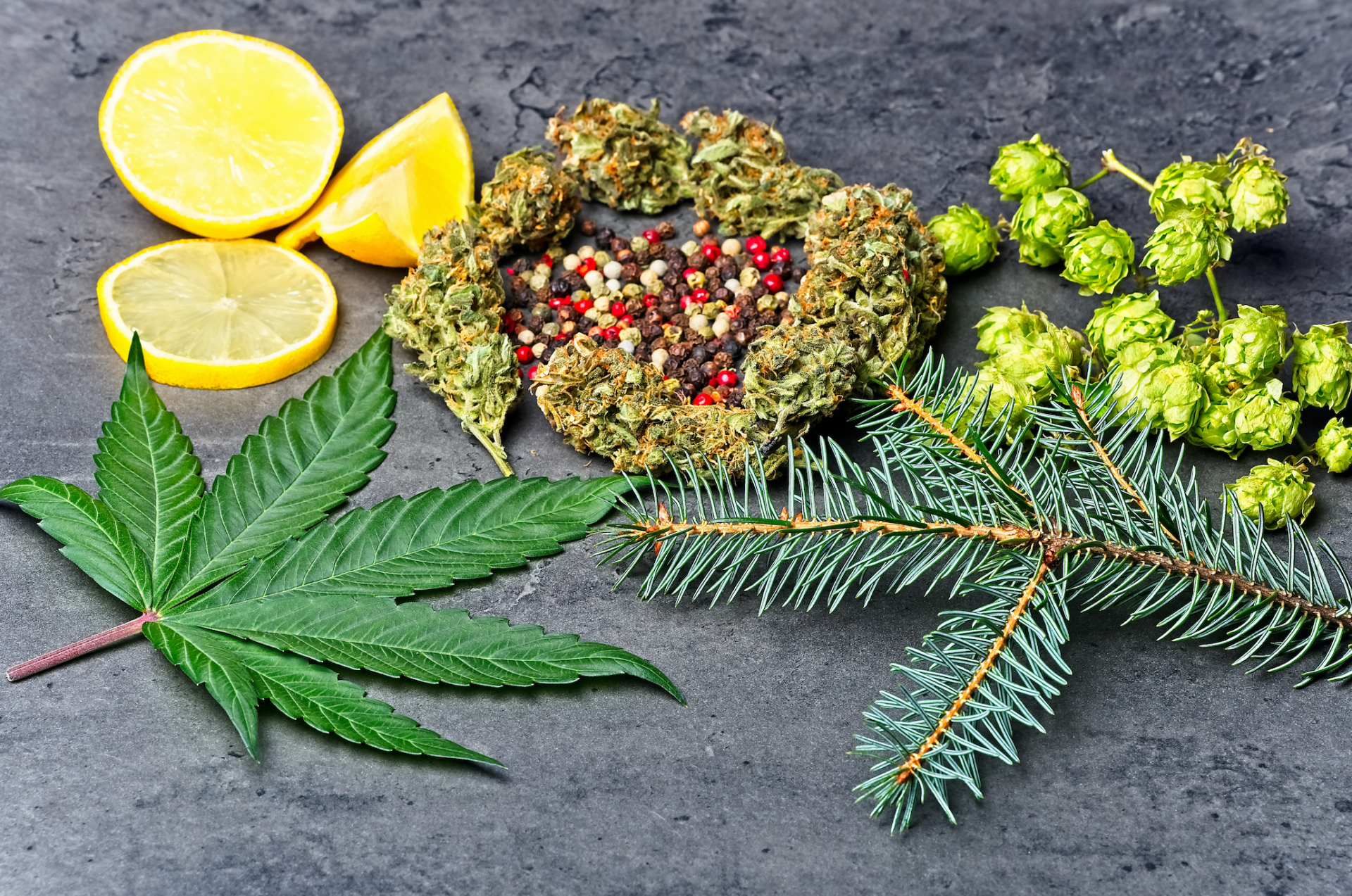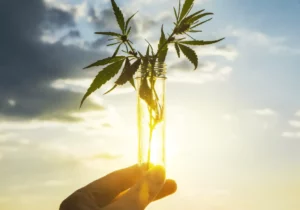Biting into a fresh, juicy orange is a tasty way to get your daily dose of immune-boosting Vitamin C, but that orange also contains a hefty helping of terpenes – natural substances that not only add flavor and fragrance but also plenty of benefits for the health of body and mind. Vitamins and terpenes go hand in hand for good health, and they can also be combined in many ways.
Combining Terpenes and Vitamins for Better Health
The natural way to get your terpenes and vitamins is through whole foods that contain them both. But terpenes can also be added to all kinds of foods and beverages not only for extra flavoring and aromas, but also for their health benefits.
We’ve listed three excellent terpene and vitamin combinations to get you started with eliminating stress, boosting a better night’s sleep or combatting chronic pain. We also go into depth about the additional health benefits of terpenes as nature’s ultimate defense!
1. Limonene & Ashwagandha for Stress Relief
Limonene is found in the rind of citruses such as orange and lemon and is even found in juniper. It is suggested that the terpene limonene will provide relief from anxiety and stress. Cannabis strains that are abundant in limonene are White Fire OG, Purple Hindu Kush, and Cinex.
Ashwaganda, also called Indian ginseng, is an adaptogenic herb that is known to help with stress, anxiety relief, and depression. A recent study showed that participants given ashwagandha for 60 days showed marked improvement from symptoms of depression.
2. Linalool & Vitamin D for Better Sleep
Lavender scented sachets are put in underwear drawers, and yoga studios pass out lavender-sprayed eye covers during finally resting. The terpene linalool gives lavender its unique scent known to soothe frazzled nerves and promote a better night’s sleep through its calming, relaxing effects. Cannabis strains high in linalool are Grandaddy Purple, Lavender Kush, and Fire OG.
Combining Vitamin D with linalool may be a winning combo for sleeping through the night. Vitamin D deficiency is linked to poorer sleep quality and quantity. Studies have shown that shorter sleep duration is linked to a lack of Vitamin D.
3. Caryophyllene & Vitamin B3, B12 for Chronic Pain
Caryophyllene is a terpene well known for its pain-relieving qualities and is found in rosemary, cloves, hops, and more. If you think of black pepper and its spicy kick, caryophyllene is behind that! Caryophyllene works with the endocannabinoid receptors in our body to fight inflammation. Studies have shown caryophyllene reduces pain in mice. Cannabis strains with caryophyllene are Bubba Kush, Sour Diesel and GSC.
Vitamin B is well-known to give an added energy boost, especially when we need a kick in the pants but it also helps combatting chronic pain. B12 helps with cell reproduction but also acts protects our nerves. B3 promotes a strong nervous system and also boosts the effects of over the counter medications such as ibuprofen.
…But What Are Terpenes?
Terpenes are natural chemicals found in plants, insects, and animals. They’re part of a large chemical family consisting of various combinations of a precursor called isoprene. So far, science has identified over 10,000 known types of terpenes. They can be classified according to the number of isomers, or replications of the isoprene molecule, that they contain.
Terpenes typically add flavor and fragrance to plants of all kinds. That orange we mentioned; it gets its sweet citrus scent and taste from terpenes, including limonene. This zesty terpene is also abundant in other citrus fruits, including lemons (of course), limes, grapefruit, and tangerines.
The rich, earthy scent of pine needles comes from a terpene called pinene, which is also found in plants such as celery and rosemary. Likewise, the terpene linalool adds a sweet floral scent to plants like lavender, jasmine and thyme.
Plants are the major source of terpenes, and these substances are also found in insects, who use them to repel invaders and attract mates. Terpenes are also produced by some animals’ livers and tissues, like the high-level sesquiterpene (one that contains three units of isoprenes) squalene.
How to Use Terpenes
Terpenes can also be synthetics developed in laboratories, and they can also be bioengineered from natural substances such as yeast and bacteria. In a recent development, scientists developed the terpene limonene from the e. coli bacterium – the one responsible for massive outbreaks of "food poisoning" and unpleasant gastric distress.
Terpenes from all these sources are used in products such as food flavorings, essential oils, personal care items like soaps and shampoos, and even industrial solvents and cleansers.
But any terpene product developed for consumption in the US, such as a flavoring, must have the label Generally Regarded as Safe, or GRAS, from the Food and Drug Administration. Because terpene isolates are a relatively new product, they need to qualify as a New Dietary Ingredient, or NDI. Getting that designation depends on the original source of the terpene.
Terpenes can only qualify as a dietary ingredient if it can be clearly established that they came from a source that’s generally regarded as food. For example, the terpene beta-caryophyllene can come from cannabis, lima beans, and insects like the Asian Lady Beetle. But only b-caryophyllene extracted from the plant sources could be considered an NDI.
Ladybugs don’t count – unless they were once considered edible.
The Hidden Health Benefits of Terpenes
But terpenes don’t have to be consumed in order to provide considerable health benefits. Terpenes such as linalool, a substance found in the soothing lavender plant, can also be used in aromatherapy or skin preparations. Terpene oils can also be added to vaping cartridges.
Research on terpenes continues to reveal an array of health benefits. Many common terpenes including linalool, limonene and myrcene, a terpene found in mangoes, lemongrass and several herbs, can boost immune functioning. and reduce inflammation.
Some studies have discovered that some terpenes including alpha-humulene and alpha-phellandrine can actively induce apoptosis, or the process of cell death, which could make them a potent tool for fighting certain kinds of cancer.
.
Other terpenes such as linalool and beta-pinene can help to reduce anxiety and depression. And myrcene has the unique function of increasing the permeability of the blood-brain barrier. This layer of endothelial cells prevents toxic or damaging substances from entering the brain, but it can also keep beneficial substances such as medications out. Myrcene can act as a kind of "escort" for those substances to help them reach the brain.
On their own, terpenes have considerable benefits for the body and mind. And when they’re combined with vitamins, studies suggest that those benefits become even more powerful.
The Terpene-Vitamin Connection
Terpenes work closely with vitamins to enhance immune-boosting and a myriad of other health benefits. Terpenes and vitamins both occur naturally in many foods, such as oranges, mangos, and hops. The grain used to make beer, so eating these foods naturally provides the health benefits of both.
The fat-soluble vitamins A, E, D and K can actually be classified as terpenes themselves. These fat, or lipid-soluble, are stored in the body’s fat cells and have structures derived from the basic isoprene units that form terpenes. For example, vitamin D, an essential vitamin that supports immunity, bone growth, and many other functions, comes from a steroid called ergosterol, a distant derivative of the terpene squalene.
Because terpenes occur naturally in so many foods and plant products, they’re generally considered non-toxic and safe for consumption. They can safely be combined with various vitamins to boost their beneficial properties. Terpenes can be harmful, though, and that’s largely due to their processing.
Today, terpenes are sold as isolates, pure terpenes in the form of oils or powders that are extracted from the natural source through a variety of processes that can involve toxins or impurities. That can become dangerous if these terpene formulations are heated to high temperatures, such as in dabbing or vaping cannabis.
Terpene isolates from a variety of plant sources including cannabis are sold by companies around the world. If you’d like to try adding terpenes
to your diet, check the labels and manufacturing information to ensure that the terpenes you buy are:
- Labeled GRAS, or food-grade
- Have been produced with toxin free processes
- Pure terpenes without added ingredients
The health benefits of vitamins have been well known for years. But now, research is revealing a multitude of benefits from plant terpenes like myrcene and linalool – and these natural substances can pair with familiar vitamins to boost immune function, improve mood, and more.






